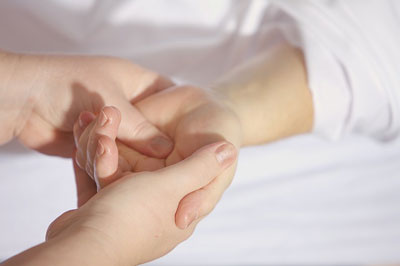 Trigger points are accumulations of waste products around a nerve receptor. Often times they feel like nodules or taut bands of fibers within the soft tissues. Trigger points form in muscles which have been overused or injured due to an accident or surgery. Common characteristics are increased muscle tension and muscle shortening. Increased muscle tension is the primary side-effect of trigger points and pain is the most common secondary effect. Trigger points can present themselves as sharp pain, dull ache, tingling, pins and needles, hot or cold, as well as can create symptoms such as nausea, ear ache, equilibrium disturbance, or blurred vision.
Trigger points are accumulations of waste products around a nerve receptor. Often times they feel like nodules or taut bands of fibers within the soft tissues. Trigger points form in muscles which have been overused or injured due to an accident or surgery. Common characteristics are increased muscle tension and muscle shortening. Increased muscle tension is the primary side-effect of trigger points and pain is the most common secondary effect. Trigger points can present themselves as sharp pain, dull ache, tingling, pins and needles, hot or cold, as well as can create symptoms such as nausea, ear ache, equilibrium disturbance, or blurred vision.
Trigger Point Massage
Trigger Point Massage relieves the pain and muscle shortness caused by the trigger points. It can be painful for a brief moment, then as the muscle relaxes and releases the trigger point the relief is tremendous.
Trigger Points can exist in two states, either active or latent. Active trigger points are those which cause discomfort. Latent trigger points wait silently in the muscle for a future stress to activate them. Aches and pains which began in the past become more frequent and severe in intensity as we age. It is common to attribute this discomfort to arthritis instead of our tight muscles which harbor trigger points. Trigger point massage is not a relaxing, “fluff and buff” technique. It requires the participation of the client to communicate the presence and intensity of pain and discomfort. The therapist and client work together as a team to maximize the effectiveness of the treatment.
What common conditions are thought to be caused by Trigger Points?
Trigger Points are known to cause or contribute to headaches, neck and jaw pain, low back pain, the symptoms of carpal tunnel syndrome and tennis elbow, and many kinds of joint pain mistakenly ascribed to arthritis, tendonitis, bursitis, or ligament injury. Referred pain caused by trigger points is usually steady, dull and aching. It is often a deep pain. It may occur at rest, or only on movement. The intensity of this pain varies from mild discomfort to severe and incapacitating pain.
